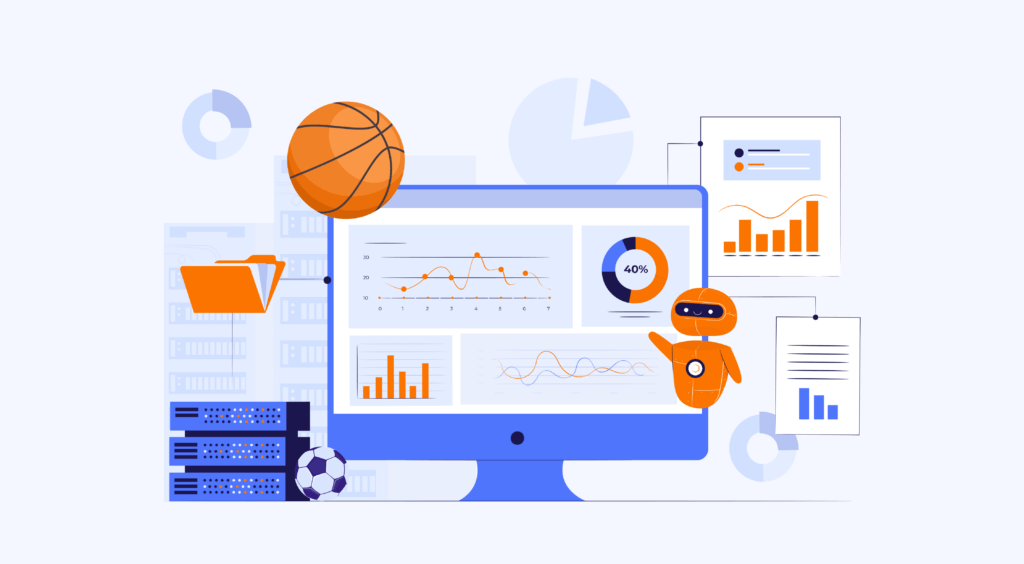
What is first-party data? And why should sports organizations prioritize having one? To answer these questions, this blog post will cover 5 reasons why sports organizations need a first-party data strategy. And how doing so will not only allow you to reach your supporters but also level up your revenue streams.
Ready? Let’s dive right in.
Before we dive right in...
Subscribe to our blog today to ensure that you never miss valuable posts such as this one. We are passionate about helping sports organizations deliver a world-class fan experience, because better fan experience means better business. So why not use this opportunity to the fullest?

What is first-party data?
To understand why you need a first-party data strategy, we first need to define what first-party data is.
First-party data is data you can collect from online and offline sources that belong to your sports organization. These sources could include your:
- Ticketing system
- Point of Sale (POS) system for food and beverage purchases
- Online POS or e-commerce store for your merchandise
- App
- OTT streaming service
- Social media platforms
- Membership lists
- Newsletter and mailing lists
- Event sign up sheets
As you can see, there are plenty of sources from which you can collect first-party data. But it doesn’t stop there, because you can also collect different types of first-party data.
To name a few, you can for instance collect data about your supporters’:
- In-stadium purchases
- Ticket purchases
- Stadium entrances
- Personal details
- Merchandise information
- Demographics
- Web- and app behavior
…and the list goes on.
By analyzing your first-party data, you can uncover key insights about your supporters:
- characteristics,
- preferences,
- and behaviors.
We’ll be exploring this in more detail later on in the blog post. But before we do, it’s important to first understand the difference between first-party data and other types of data.
First-party data vs. other types of supporter data
Aside from first-party data, there are some other types of data that you should know about. By knowing the differences between them, you will avoid mixing them up. And this will also make it easier for you to set up a first-party data strategy.
First-party data vs. Zero-party data
While first-party data is the data that you collect yourself, zero-party data is data that your supporters share with you. This means that your supporter needs to intentionally and proactively share their data with you for it to be called zero-party data. So, similar to first-party data, this makes zero-party data a data type of high quality and accuracy. And this is because it’s the supporters themselves that have decided to share it with your organization.
First-party data vs. Second-party data
Second-party data is data that you can acquire from trusted partners. Usually, the partner is someone you already know, such as one of your trusted sponsors. This means that second-party data is also data of high quality and accuracy. And just like for your sports organization, your partner needs to comply with privacy regulations, such as GDPR and the CCPA.
First-party data vs. Third-party data
Finally, we have third-party data. As the name suggests, this is the type of data that you acquire from a third party. In this case, it will be third-party data providers (also known as data aggregators). These data aggregators collect data from other organizations and then compile it into a single set of data which you can then buy. As you can imagine, this means that third-party data can enrich your own data. Moreover, it can also help you learn even more about your target market.
There is, however, a challenge with third-party data. And this challenge is that you usually don’t know where the data originally comes from. This is because the data sets are large and sold programmatically. This in turn leads us to another obstacle with third-party data: it is usually not compliant with privacy regulations. And this is one of the 5 reasons why sports organizations need a strategy for their first-party data.
Which brings us to…
5 reasons why sports organizations need to implement a first-party data strategy

Changes in supporter behavior driven by digitalization
It’s no secret that digital transformation has brought about changes in how we behave and choose to interact with brands. Today, more and more supporters are choosing to interact with sports organizations outside of the stadium. They might:
- Prefer to stream games from the comfort of their homes,
- Have conversations with other supporters online,
- Watch non-live content, such as exclusive behind-the-scenes footage offered via your OTT platform.

To learn more about the latest sports marketing trends, check out this blog post >>
Another factor that goes hand in hand with digitalization is the new preferences of generation Z. Gen Z are digital natives. And this younger supporter crowd demands experiences that are personal, relevant, and engaging. They want to interact with your brand on their terms. That is, when they want, and where they want – in their preferred channel or platform. Moreover, Gen Z also happens to be the biggest consumer cohort globally, with a spending power of more than $140 million in the US alone. So, this demographic simply cannot be ignored.

“If they want to attract and retain young viewers, sports leagues and broadcaster will have to provide more customizable, personalized content.”
– Marcos Gonzalez-Flower | Global Head of Media Competence Center at Atos
Based on these behavior changes, we understand that supporters want to receive experiences that are:
- Personal
- Seamless
- Consistent
on all channels where your organization is active.
But to deliver these experiences, you need to know enough about your supporters’ specific:
- Characteristics,
- Preferences,
- Behaviors.
What does this mean? Well, it means you need both enough data and the right data about your supporters.

Learn more about how a CDP can help you create fan experiences that are personalized, relevant, and engaging across the entire fan journey.
Start now >>
As we have covered earlier in the blog post, there are different types of data that you can collect about your supporters, including first-party data. However, a greater number of organizations have previously relied on third-party data to gain relevant information about their supporters.
However, this is all about to change because of…
Let’s go back to third-party data.
So far, we know that this type of data is collected and sold by data aggregators. But how exactly do they collect the data? Well, via third-party cookies.
But what are third-party cookies?
In short, a third-party cookie is a piece of tracking code. And this tracking code is placed in your web browser after visiting a website. However, this tracking code is created by the data aggregator and not by the website itself. If it were, then it would be called a first-party cookie.
Okay, so why the “death” of third-party cookies?
Well, as we’ve mentioned earlier in this blog post, the main problem with third-party data is that you don’t know its original source. Consequently then, more and more people started to worry about how their data is being used. So as a reaction to this, several privacy regulations were set in motion. And with big players such as Apple, Google, and Mozilla removing third-party cookies altogether, the death of third-party cookies inevitably became a reality.
Below, we can see the effects of phasing out third-party cookies on marketing data use in North America as of January 2022.
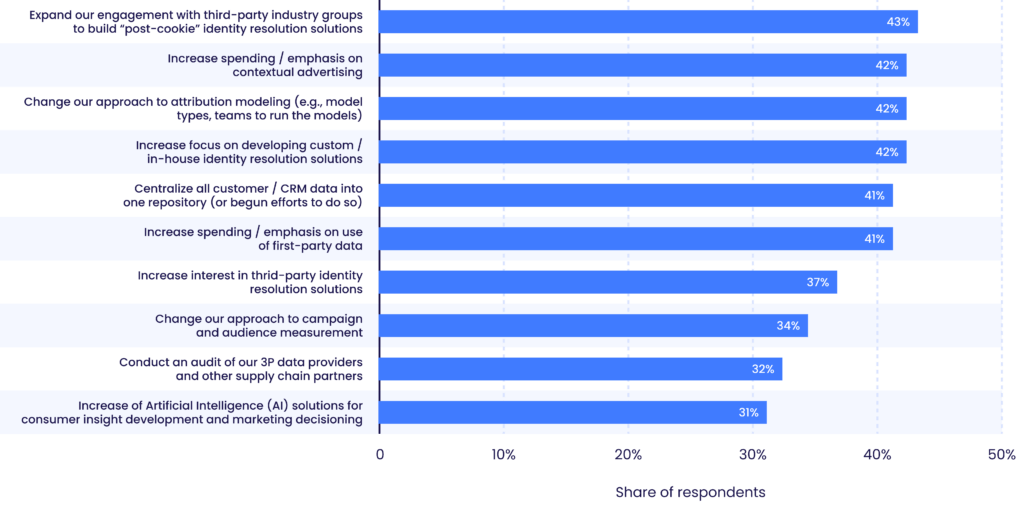
Source: Statista
As we can see above:
- 41% of respondents said that they want to increase spending/emphasis on the use of first-party data.
- 41% also responded that they want to focus on centralizing all their customer data into one repository. This goes hand in hand with implementing a first-party data strategy. Because in order to truly leverage a first-party data strategy, you first need to unify all your data in one place.
- 37% of respondents have an increased interest in third-party identity resolutions. In other words, these are technology solutions that allow you to match personal identifiers across devices and touchpoints to a single profile.
Okay, but what exactly does this mean for sports organizations?
Of course, these numbers account for multiple industries. But sports organizations are no exception to these changes.
Like any other organization, sports organizations can no longer rely on third-party data as their primary source of data. Instead, they need to return to the drawing board and create a new data strategy. And in this strategy, they need to prioritize their supporters’ privacy and security. If they don’t, it will be nearly impossible to deliver the experiences that their supporters demand.

“Effective supporter engagement relies heavily upon having the best data possible to enable highly personalized interactions with supporters. As such, sports organizations should put the security of supporter connections and data at the center of their digital strategies in order to maintain trust. […] As a result, sports organizations are emphasizing consent-based data marketing, increasing the roles and responsibilities of data controllers, and adjusting budgets to account for the cost of complying with data privacy regulations.”
– Pete Giorgio | US Sports Practice leader Deloitte Consulting LLP
But it’s not all dark and gloomy. Because you’re already sitting on a goldmine of data. And that data is:
your very own first-party data.
As we have established earlier, your first-party data can be found in your different online and offline sources.
What makes first-party data so valuable is that:
- The data belongs to you
- You haven’t had to pay for it
- To own your data, you first need to receive consent from your supporters
So, by collecting and centralizing all your first-party data in a single place, you are then able to…

Get a 360-degree supporter view [using a Sports CDP]
But wait, do you know what a 360-degree supporter view means?
As you might have guessed, it means that by collecting and unifying your first-party data, you can create a holistic view of each supporter. In other words, this means that you will obtain a rich and detailed profile of each supporter, including information such as:
- Age
- Gender
- Income
- Family size
- Address
- Behavior such as:
- Ticket purchase history
- Merchandise purchases
- OTT watching history
- Social media activity
- Value-level like for instance:
- Regular supporter – brings up a smaller portion of your revenue
- Mid-level supporter – brings in more money than your regular supporter
- Superfan – stands for a majority of your revenue (top 20% of your supporter base)
and the list goes on.
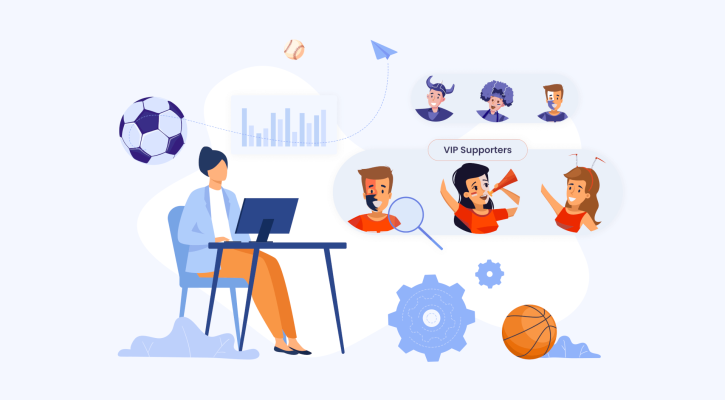
To learn more about segmentation, check out this blog post >>
As we can see in the list above, there is almost no limit to how detailed your supporter profiles can be. That is, as long as you have collected and unified your first-party data. Which brings us to another question:
How exactly do you collect and unify your data?
To understand how you can do this, we first need to look at some of the challenges sports organizations face when trying to implement a first-party data strategy.
And some of the most common challenges are:
- Having their data stored in many different sources
- Data silos, which means that the data are separate from each other and not accessible to everyone in the organization
- The data is obsolete and no longer valuable to you
- You have a lot of incomplete data because you haven’t unified it
This means that sports organizations need a solution that can solve these challenges for them. And this is exactly what customer data platforms have been created for, which is to:

Collect and centralize your data.
By unifying your data, a CDP makes your data available to everyone at your organization that needs it - creating a single source of truth.

Analyze and uncover insights from it.
Because you have all your data unified in the CDP, you can now easily gain relevant insights into your supporters' characteristics, preferences, and behaviors.

Act on these insights.
A CDP then lets you segment your audience into different groups based on these insights. You can then act on them via different tools, such as a marketing automation tool, CRM, Social Media, etc. Then via these tools, you can deliver messages and experiences in your supporters' preferred channels and platforms.
How does a sports CDP work?
Check out the image below to see how exactly a Sports CDP works:
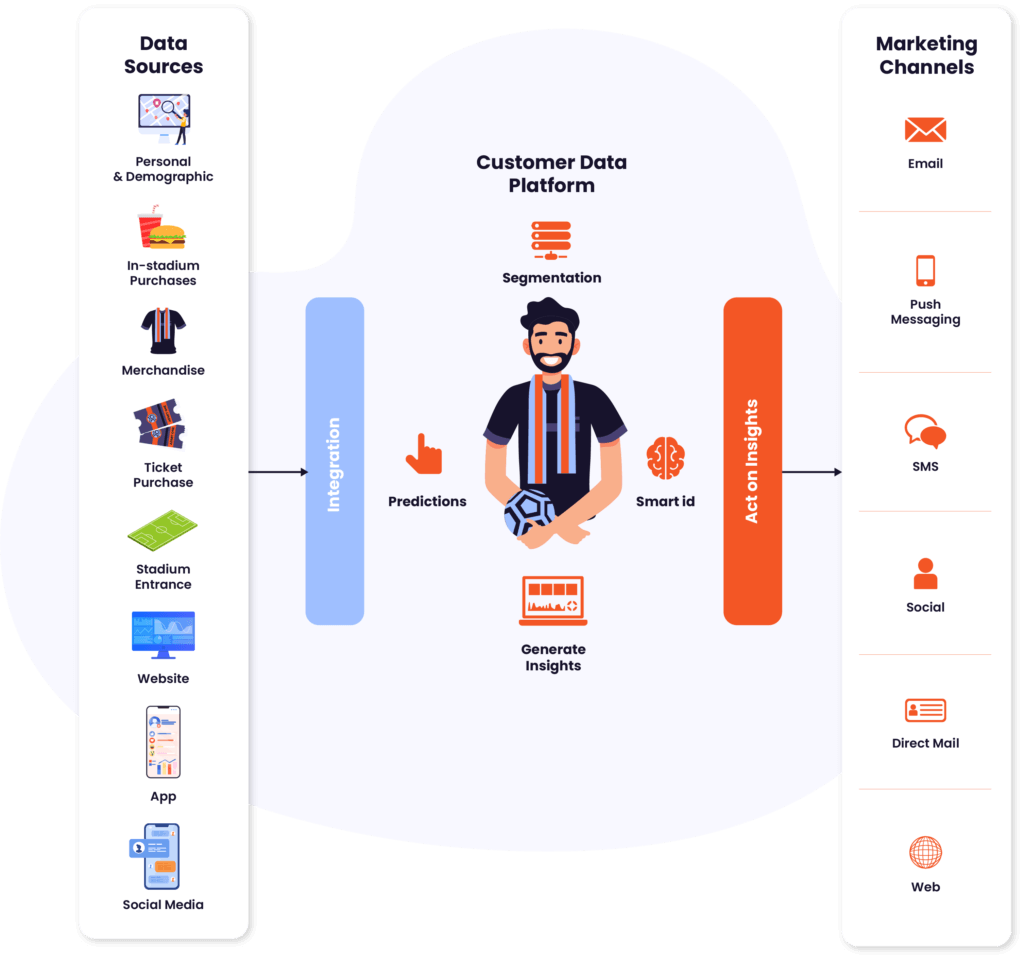
As we can see, CDPs enable organizations to collect, analyze, and act on their first-party data. It perhaps then doesn’t come as a surprise that customer data platforms have experienced immense growth in recent years. And this growth is expected to continue at an exponential rate:
In fact, the global CDP market size is expected to grow from $2.4 billion in 2020 to $10.3 billion by 2025, at a CAGR of 34% during the forecast period.
Customer Data Platform Market, By Region (USD Billion)
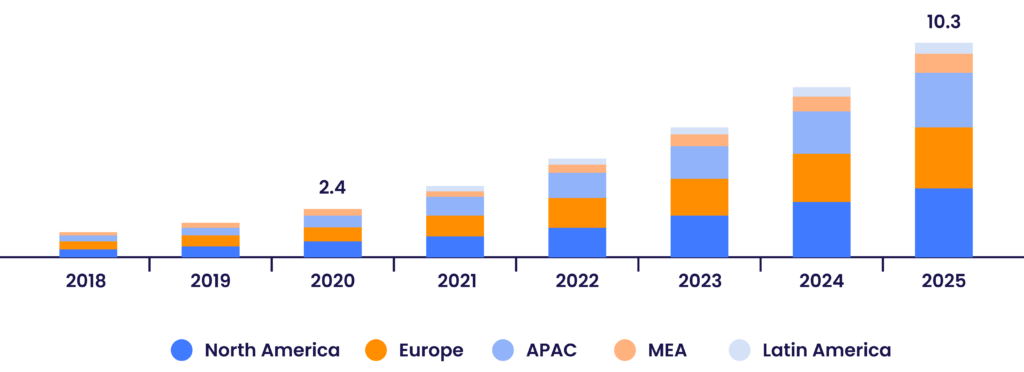
Source: MarketsandMarkets Analysis
Yes, that’s right. The global CDP market size is expected to grow to a whopping $10.3 billion by 2025.
And with the inevitable death of third-party cookies, CDPs are going to be one of, if not the, most important solutions to develop a first-party data strategy that is:
profitable and sustainable.
In addition, your strategy will be even more successful if you choose a CDP that has been built and designed for your industry, such as Data Talks Sports CDP. Because then you will not only have a solution that is tailored to your sports organization’s specific needs. But your CDP provider will also be an industry expert.

“I really appreciate Data Talks’ expertise at the crossroads of data and sports – this is rare. They put in a lot of effort and heart into our project to make it a success”
– Florian Ludewig | Senior Director Data Warehouse at SPORTFIVE
But it doesn’t stop there. Because in addition to leveraging your first-party data to reach and engage with your supporters, a CDP will also enable you to:
- Gain insights that help you make better and even more accurate decisions
- Execute effective and streamlined work through data democratization
- Better monitoring and reporting of your marketing efforts
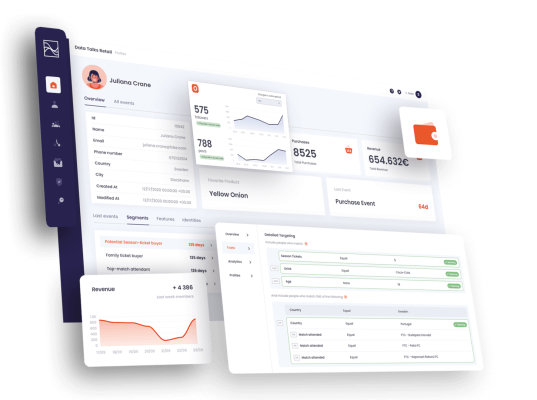
Getting started is easy
Explore Demo Now >>
In sum, adding a CDP to your technology stack will make your first-party data strategy come to life. And as you can imagine, you can reap so many different benefits from implementing a first-party data strategy.
And one of these many benefits is that you can…

Grow your supporter base and build long-term loyalty
That’s right. Thanks to your first-party data strategy, enabled by a CDP, you now not only understand your supporters better. Now, you can also uncover who your biggest supporters are.
And it doesn’t stop there.
Because by knowing the traits of your biggest and most loyal supporters, you can also find people who have these exact same traits. In other words, this means that:
You can grow your supporter base!
Isn’t this cool? By simply leveraging your own first-party data, not only are you able to discover who your high-level supporters are. But now, you are also able to find other people with the same traits as them – aka, lookalike audiences.
So, now the next step is to target these lookalike audiences.
And just like your existing supporters, your lookalike audience wants to receive interactions and experiences that are:
- Personal
- Relevant
- Engaging
To achieve this, you need to create supporter experiences that are hyper-personalized.

To learn more about hyper-personalization, read this article >>
Specifically, you can win your audience over by delivering:
- the right message
- to the right person
- in the right channel
at the right time
“With a defined and robust first-party data strategy, sports properties and media owners will have the foundation they need to make authentic supporter connections—delivering timely and nuanced messaging.”
Source: Nielsen’s 2022 global sports marketing report
When you deliver these types of experiences, you will create a direct relationship not only between you and your existing supporters. Now, you can also do this with your lookalike audiences. And in the long run, this will allow you to increase your supporter base in tandem with your supporter loyalty.

Optimized partnership and sponsorship deals
Throughout this blog post, we have mainly discussed how a first-party data strategy can help you reach, grow, and convert your supporter base. But did you know that it can also help you optimize your partnership and sponsorship deals?
You read that right. And here is why:
As you know, more and more supporters today are using different platforms and are active in more channels than ever. As a result, this makes it more challenging for sports organizations to measure sponsorship efforts. More specifically, it will become even harder to attribute and validate sponsorship returns across different channels. Consequently then, sports organizations risk leaving money on the table. And this is a shame because sponsorships have been proven to drive a:
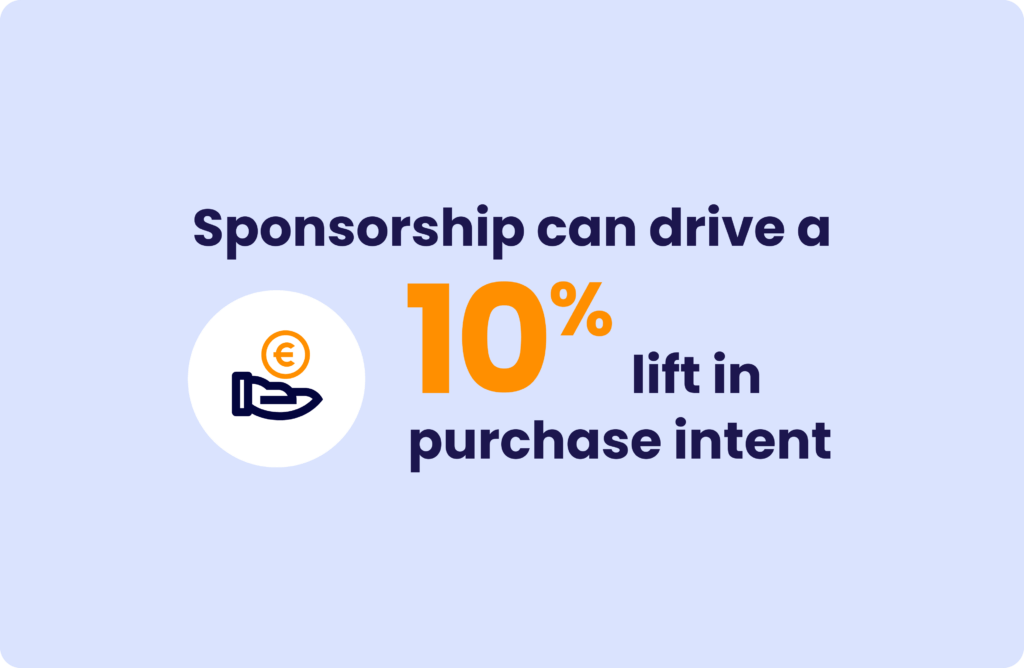
Source: Nielsen, 2022
But of course, this is not the end of the story. Because if sports organizations implement a first-party data strategy, enabled using a sports CDP, they can remove this “blindfold” and see clear. Because by unifying your first-party data, you can map out which supporters and channels that are bringing in the sponsorship returns.
And it doesn’t stop there.
By having the right data insights, your sports organization can also tap into new sponsorship opportunities. Since traditional and digital worlds are quickly merging, this means that sponsorship life cycles are also becoming longer. In other words, there is even more money to make. And by having a first-party data strategy in place, powered by a sports CDP, sports organizations can make the most of these longer sponsorship life cycles.
How exactly?
Once again, by making sure you deliver experiences that are personal, relevant, and seamless across the entire supporter journey. If you manage to do this, both you and your sponsors will win big time.
The next step: implement a first-party data strategy
In this blog post, we have covered what first-party data is and 5 reasons why sports organizations should prioritize having one.
Now, it’s time to implement your first-party data strategy. But before you do, remember to first have the right technology in place in order to collect and centralize your first-party data. Only then will you be able to uncover relevant insights from the data about your supporters. Insights that allow you to understand your supporters’ characteristics, preferences, and behaviors.
Having these insights will let you target your fans with communications and interactions that are:
- Personal
- Relevant
- Engaging
And when you deliver such experiences you will receive results such as:
- Boosted revenue
- Increased engagement
- Stronger supporter loyalty
- Growing your supporter base
- Optimized partnership and sponsorship deals
What happens if you skip this step? Well, then it will become nearly impossible to implement an effective, sustainable, and ultimately, successful first-party data strategy.
Feeling unsure where to start? Then reach out to us at Data Talks, we would be happy to help you embark on this epic journey!
Leave a Reply